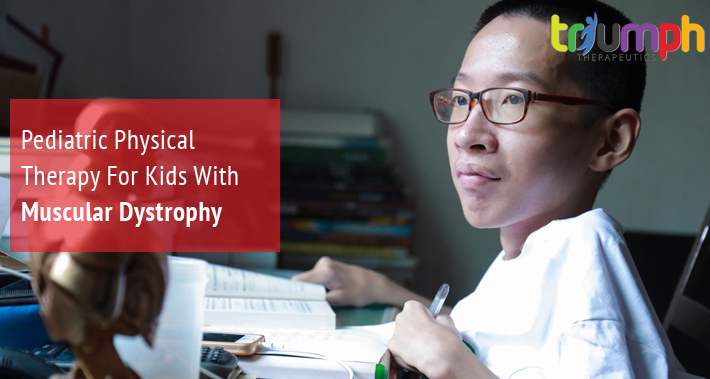Pediatric Physical Therapy Treatments For Kids With Muscular Dystrophy
https://www.triumphtherapeutics.com/wp-content/uploads/2022/03/Triumph-Therapeutics-Speech-Therapy-OT-Physcial-Therapist-Washington-DC-Mar03-01-2022.jpg 710 379 Triumph Therapeutics Triumph Therapeutics https://www.triumphtherapeutics.com/wp-content/uploads/2022/03/Triumph-Therapeutics-Speech-Therapy-OT-Physcial-Therapist-Washington-DC-Mar03-01-2022.jpgMuscular dystrophy is a broad category of inherited genetic disease.
If your child has been diagnosed with it, it’s imperative that you start a treatment plan as soon as possible.
This is to prevent any stiffening of their joints and muscles.
Early intervention will help them to live mobile, independent lives.
That’s why if your child has been diagnosed with muscular dystrophy, it’s important that you bring them to see a Washington DC pediatric physical therapist as soon as possible.
Let’s take a closer look at muscular dystrophy.
What Is Muscular Dystrophy?
Muscular dystrophy is a category of genetic disease caused by a gene mutation in your chromosomes.
It is a progressive disease which is characterized by muscular weakness and decreased muscle mass.
The “progressive” in the name means it gets worse over time.
Other progressive diseases include:
- Multiple sclerosis
- Alzheimer’s disease
- Parkinson’s disease
- ALS
- Osteoarthritis
These diseases don’t tend to affect children, however – thankfully, progressive disorders that affect children are rare.
There are currently nine different types of muscular dystrophy that have been identified, although each of these has many variations or subtypes.
Some of the most common types of muscular dystrophy include:
- Becker
- Duchenne
- Myotonic
- Facioscapulohumeral
What Causes Muscular Dystrophy?
This is a genetic disease, which means that you must inherit it from your parents in order to have it.
You can’t get it through injury or illness, but you can inherit it even if your parents don’t have it.
There are three ways you can inherit muscular dystrophy.
Autosomal dominant inheritance is when you receive a normal gene from one parent and a defective gene from the other parent.
There is a 50% chance of inheriting the gene in this case, which causes muscular dystrophy.
The second type of inheritance is called autosomal recessive inheritance.
This occurs if both of your parents carry and pass on the defective gene, but neither of them have the disease.
In this case, there’s a 50% chance of inheriting one gene and becoming a carrier, and a 25% chance of inheriting both defective genes and developing the disease.
Finally, the third way you can get muscular dystrophy is by the x-linked recessive inheritance, which is when you carry the muscular dystrophy gene on one of your two X chromosomes and passes that gene on to your child.
This usually can only be passed from a parent with XX chromosomes to a child with XY chromosomes.
What Are The Symptoms Of Muscular Dystrophy?
All types of muscular dystrophy are characterized by progressive muscle weakness, which leads to muscle wasting.
This process can also cause the shortening and hardening of muscles, tendons, and tissues which affects your joints, spine curvature, respiratory and cardiac problems.
The following symptoms can commonly be found in children:
- Developmental delays, particularly in motor skills development
- The Gowers sign, which is a particular way a child pushes themselves up by using their hands on their thighs to stand
- Turning on their stomach before getting up from the floor after they’re three and a half years old
There are some other symptoms that can be associated with muscular dystrophy including cognitive challenges, speech and language challenges, and behavioral issues.
As a result, your child’s treatment may also include pediatric speech therapy and pediatric occupational therapy.
How Is Muscular Dystrophy Diagnosed?
A physician is usually required to make a diagnosis of muscular dystrophy.
They can do this by following a number of steps to rule out other possible causes.
First they’ll order blood tests to determine the levels of muscle proteins and then, if there’s an alteration in the levels, refer your child to a specialist for genetic testing.
They may also conduct a muscle biopsy if they feel that is the best course of action.
Newborn pediatric screening is especially important if your family has a history of muscular dystrophy, because it is a genetic disease and can be confirmed before your child is born.
How A Pediatric Physical Therapist Can Treat Muscular Dystrophy
Pediatric therapy for muscular dystrophy is especially effective when started very soon after your child’s diagnosis.
This is to prevent joint or muscle tightness from developing and to keep your child’s muscles as flexible and strong as possible.
A good physical therapist will evaluate your child to determine their particular needs and create a program to address them.
To do this there are a number of strategies they can employ to keep them mobile.
Let’s explore some strategies further.
1. Strength Exercises
Strength exercises are key to your child’s treatment program.
Your physical therapist will teach your child exercises to maintain muscle strength, good posture, and body mechanics.
Depending on the age of your child, they may identify games and creative tasks that promote these key areas.
This is also helpful to reduce the risk of obesity and maintain heart health.
2. Breathing Exercises
Breathing exercises are equally important to maintain your child’s respiratory health.
Your physical therapist will incorporate these into their custom program for this reason.
3. Developmental Skills Training
Motor skills development can be challenging for your child if they have muscular dystrophy.
Your physical therapist will teach your child to master these skills which include getting up to stand, walking, jumping, and crawling as they reach the appropriate age levels for each skill.
4. Passive Stretching And Active Stretching
Your child’s physical therapist will teach them active stretching in order to increase their joint flexibility and range of motion.
They will also passively stretch your child by gently moving their limbs and teach you how to do this for them at home.
The goal is to prevent and delay the development of any muscle and joint tightness.
5. A Physical Fitness Plan
Finally, maintaining your child’s physical fitness will help them to maintain general good health.
Included in this will be exercises, diet, and community involvement recommendations which will promote your child’s overall wellbeing.
They may also recommend mobility aids like wheelchairs, braces, or splints if they feel it necessary.
Book Your Appointment With Triumph Therapeutics Today
You can see the wide benefits to working with a physical therapist if your child has been diagnosed with muscular dystrophy.
By starting early, your physical therapist can work with your child to delay and prevent any muscle or joint tightness from occurring.
This is very important to the long term mobility and independence of your child.
Book an appointment today with Triumph Therapeutics to get started.


